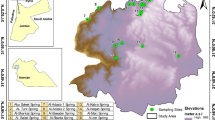Abstract
A hydrogeochemical survey was conducted on Pico Island (Azores archipelago) in order to evaluate the groundwater chemistry patterns and the main mineralization processes. Samples were from cold waters and corresponded mainly to sodium chloride type. Conductivity measurements were ∼82–9790 μS/cm and suggest the existence of highly mineralized waters. In fact, 18% had a conductivity >5130 μS/cm and the total dissolved solid (TDS) value for two of the wells was from the brackish water range. The changes in groundwater composition are because of two main processes: (1) silicate mineral dissolution, especially in a few springs located at high altitude and (2) water salinization in the coastal area, as a result of saltwater intrusion and sea-salt spraying. The salinization process corresponds to a binary mixing system, as suggested by the chloride and δ18O data, and explains the sharp concentration increase in major and minor species detected in several wells.
Similar content being viewed by others
Author information
Authors and Affiliations
Additional information
Received: 23 July 1999 · Accepted: 8 December 1999
Rights and permissions
About this article
Cite this article
Cruz, J., Silva, M. Groundwater salinization in Pico Island (Azores, Portugal): origin and mechanisms. Environmental Geology 39, 1181–1189 (2000). https://doi.org/10.1007/s002540000109
Issue Date:
DOI: https://doi.org/10.1007/s002540000109




